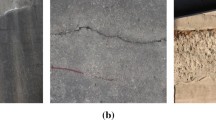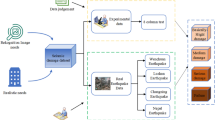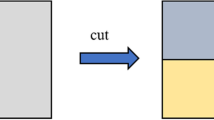Abstract
Exposed aggregate is a typical feature of the abrasion erosion in stilling basin slabs concrete surface. Although a variety of underwater robots are designed for inspection, the exposed aggregate detection for identifying abrasion is often done by manual work. The scarcity of image samples, large differences in aggregate size, color and shape are the main difficulties in automatic detection. To address this problem, an improved Attention U-Net deep fully convolutional network-based detection method was proposed. To realize this method, underwater images in site were captured via a self-developed operated underwater robot. Through randomly separating and the cropping of the 128 underwater images, the 512×512 pixels images dataset was built according to the ratio of 8:1:1, including 408 training images, 52 validation images and 52 test images. After the data augmentation, loss function and the optimizer were carefully designed and selected, the proposed Attention U-Net architecture was evaluated on this dataset. For comparative research, the full convolution network (FCN) and U-Net network were trained with the same training and validation dataset. The performance comparison on the test dataset showed that the Attention U-Net architecture has better detection accuracy.
Similar content being viewed by others
References
Abdel-Qader I, Abudayyeh O, Kelly ME (2003) Analysis of edge-detection techniques for crack identification in bridges. Journal of Computing in Civil Engineering 17(4):255–263, DOI: 10.1061/(asce)0887-3801(2003)17:4(255)
Cha YJ, Choi W, Büyüköztürk O (2017) Deep learning-based crack damage detection using convolutional neural networks. Computer-Aided Civil and Infrastructure Engineering 32(5):361–378, DOI: 10.1111/mice.12263
Cha YJ, Choi W, Suh G, Mahmoudkhani S, Büyüköztürk O (2018) Autonomous structural visual inspection using region-based deep learning for detecting multiple damage types. Computer-Aided Civil and Infrastructure Engineering 33(9):731–747, DOI: 10.1111/mice. 12334
Chen FC, Jahanshahi MR (2018) NB-CNN: Deep learning-based crack detection using convolutional neural network and naïve bayes data fusion. IEEE Transactions on Industrial Electronics 65(5):4392–4400, DOI: 10.1109/TIE.2017.2764844
Choi S, Bolander JE (2012) A topology measurement method examining hydraulic abrasion of high workability concrete. KSCE Journal of Civil Engineering 16(7):771–778, DOI: 10.1007/s12205-012-1135-2
Choi W, Cha Y (2019) SDDNet: Real-time crack segmentation. IEEE Transactions on Industrial Electronics, DOI: 10.1109/TIE.2019. 2945265
Dinh TH, Ha QP, La HM (2016) Computer vision-based method for concrete crack detection. Proceedings of 14th international conference on control, automation, robotics and vision, November 13-15, Phuket, Thailand
Dung CV, Anh LD (2019) Autonomous concrete crack detection using deep fully convolutional neural network. Automation in Construction 99:52–58, DOI: 10.1016/j.autcon.2018.11.028
Huang H, Li Q, Zhang D (2018) Deep learning based image recognition for crack and leakage defects of metro shield tunnel. Tunnelling and Underground Space Technology 77:166–176, DOI: 10.1016/j.tust. 2018.04.002
Jetley S, Lord NA, Lee N, Torr PHS (2018) Learn to pay attention. Proceedings of 6th international conference on learning representations, April 30-May 3, Vancouver, BC, Canada
Koch C, Georgieva K, Kasireddy V, Akinci B, Fieguth P (2015) A review on computer vision based defect detection and condition assessment of concrete and asphalt civil infrastructure. Advanced Engineering Informatics 29(2):196–210, DOI: 10.1016/j.aei.2015. 01.008
Kohut P, Giergiel M, Cieslak P, Ciszewski M, Buratowski T (2016) Underwater robotic system for reservoir maintenance. Journal of Vibroengineering 18(6):3757–3767, DOI: 10.21595/jve.2016.17364
Kryžanowski A, Mikoš M, Šušteršiè J, Ukrainczyk V, Planinc I (2012) Testing of concrete abrasion resistance in hydraulic structures on the Lower Sava River. Strojniski Vestnik/Journal of Mechanical Engineering 58(4):245–254, DOI: 10.5545/sv-jme.2010.217
Li R, Yuan Y, Zhang W, Yuan Y (2018) Unified vision-based methodologyfor simultaneous concrete defect detection and geolocalization. Computer-Aided Civil and Infrastructure Engineering 33(7):527–544, DOI: 10.1111/mice.12351
Li S, Zhao X, Zhou G (2019) Automatic pixel-level multiple damage detection of concrete structure using fully convolutional network. Computer-Aided Civil and Infrastructure Engineering 34(7):616–634, DOI: 10.1111/mice.12433
Liu Z, Cao Y, Wang Y, Wang W (2019) Computer vision-based concrete crack detection using U-net fully convolutional networks. Automationin Construction 104:129–139, DOI: 10.1016/j.autcon.2019.04.005
Liu YW, Yen T, Hsu TH (2006) Abrasion erosion of concrete by water-borne sand. Cement and Concrete Research 36(10):1814–1820, DOI: 10.1016/j.cemconres.2005.03.018
Long J, Shelhamer E, Darrell T (2015) Fully convolutional networks for semantic segmentation. IEEE conference on computer vision and pattern recognition, June 7-12, Boston, MA, USA, DOI: 10.1109/CVPR.2015.7298965
Milletari F, Navab N, Ahmadi SA (2016) V-Net: Fully convolutional neural networks for volumetric medical image segmentation. Proceedings of 4th international conference on 3D Vision, October 25-28, Stanford, CA, USA, DOI: 10.1109/3DV.2016.79
Mohan A, Poobal S (2018) Crack detection using image processing: A critical review and analysis. Alexandria Engineering Journal 57(2): 787–798, DOI: 10.1016/j.aej.2017.01.020
Nair V, Hinton G (2010) Rectified linear units improve restricted boltzmann machines. Proceedings of 27th international conference on machine learning, June 21-24, Haifa, Israel
Neto EC, Sá RC, Holanda GC, Mota FAX, Varela AT, Araujo ALC, Loiola IJ, Oliveira R, Alexandria AR, Albuquerque VHC (2014) Autonomous underwater vehicle to inspect hydroelectric dams. International Journal of Computer Applications 101(11):1–11, DOI: 10.5120/17728-8801
Oktay O, Schlemper J, Folgoc LL, Lee M, Heinrich M, Misawa K, Mori K, McDonagh S, Hammerla NY, Kainz B, Glocker B, Rueckert D (2018) Attention U-Net: Learning where to look for the pancreas. arXiv:1804.03999
Ridao P, Carreras M, Ribas D, Garcia R (2010) Visual inspection of hydroelectric dams using an autonomous underwater vehicle. Journal of Field Robotics 27(6):759–778, DOI: 10.1002/rob.20351
Ronneberger O, Fischer P, Brox T (2015) U-Net: Convolutional networksfor biomedical image segmentation. Proceedings of 18th international conference on medical image computing and computer-assisted intervention, October 5-9, Munich, Germany, DOI: 10.1007/978-3-319-24574-4_28
Russell BC, Torralba A, Murphy KP, Freeman WT (2008) LabelMe: A database and web-based tool for image annotation. International Journal of Computer Vision 77(1):157–173, DOI: 10.1007/s11263-007-0090-8
Sato Y, Bao Y, Koya Y (2018) Crack detection on concrete surfaces using V-shaped features. The World of Computer Science and Information Technology Journal 8(1):1–6
Scherer D, Müller A, Behnke S (2010) Evaluation of pooling operations in convolutional architectures for object recognition. Proceedings of 20th international conference on artificial neural networks, September 15-18, Thessaloniki, Greece, DOI: 10.1007/978-3-642-15825-4_10
Shimono S, Hitoshi A, Kato S, Nishizawa U, Toyama S (2017) Evaluation of under water positioning by hanged ROV from USV. International Journal of Modeling and Optimization 7(4):224–230, DOI: 10.7763/IJMO.2017.V7.588
Shimono S, Matsubara O, Toyama S, Nishizawa U, Kato S, Arisumi H (2015) Development of underwater inspection system for dam inspection. OCEANS 2015, October 19-22, Washington, DC, USA, DOI: 10.23919/OCEANS.2015.7401929
Sudre CH, Li W, Vercauteren T, Ourselin S, Cardoso MJ (2017) Generalised Dice overlap as a deep learning loss function for highly unbalanced segmentations. Proceedings of 3rd international workshopon deep learning in medical image analysis, September 14, Québec City, QC, Canada, DOI: 10.1007/978-3-319-67558-9_28
Sugimoto H, Moriya Y, Ogasawara T (2017) Underwater survey system of dam embankment by remotely operated vehicle. IEEE underwatertechnology, February 21-24, Busan, Korea, DOI: 10.1109/UT.2017.7890298
Weng X, Huang Y, Wang W (2019) Segment-based pavement crack quantification. Automation in Construction 105:102819, DOI: 10.1016/j.autcon.2019.04.014
Yang Y, Hirose S, Debenest P, Guarnieri M, Izumi N, Suzumori K (2016) Development of a stable localized visual inspection system for underwater structures. Advanced Robotics 30(21):1415–1429, DOI: 10.1080/01691864.2016.1218794
Yang X, Li H, Yu Y, Luo X, Huang T, Yang X (2018) Automatic pixel-level crack detection and measurement using fully convolutional network. Computer-Aided Civil and Infrastructure Engineering 33(12):1090–1109, DOI: 10.1111/mice.12412
Acknowledgements
This research was supported by Sichuan Science and TechnologyProgram (2018JZ0001, 2018GZDZX0043, 2019YFG0143, 2019YFG0144, 2019YFS0057, 2019YJ0449).
Author information
Authors and Affiliations
Corresponding author
Rights and permissions
About this article
Cite this article
Li, Y., Li, X., Wang, H. et al. Exposed Aggregate Detection of Stilling Basin Slabs Using Attention U-Net Network. KSCE J Civ Eng 24, 1740–1749 (2020). https://doi.org/10.1007/s12205-020-1431-1
Received:
Revised:
Accepted:
Published:
Issue Date:
DOI: https://doi.org/10.1007/s12205-020-1431-1




